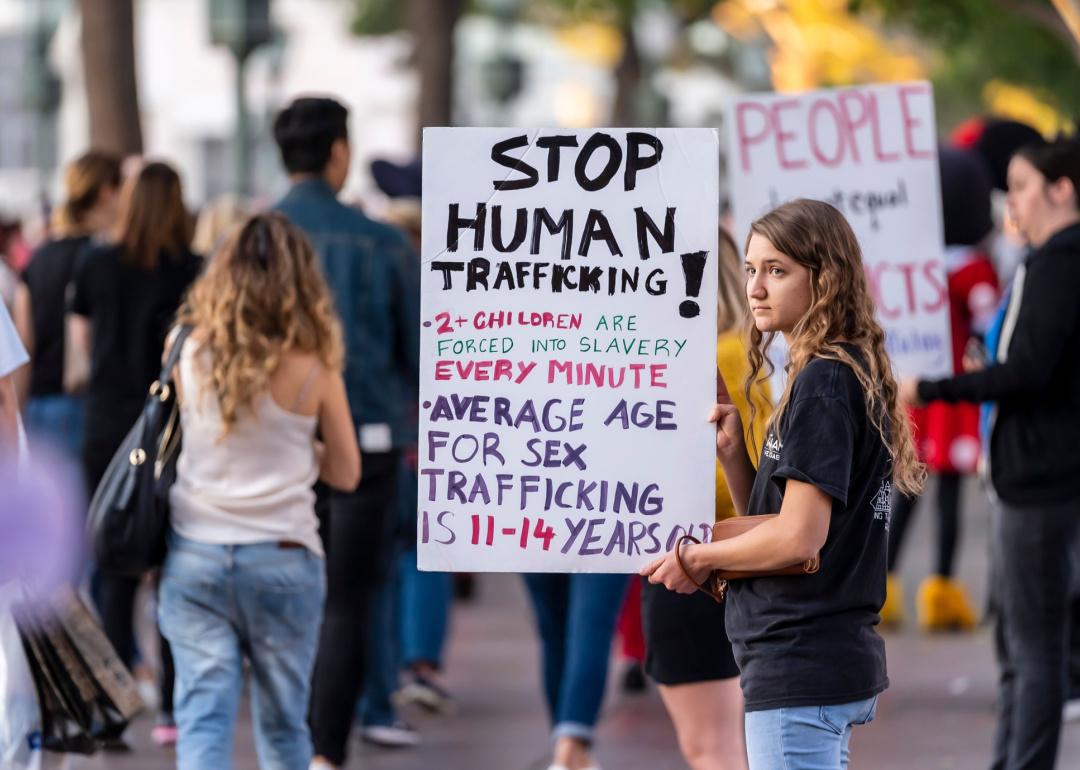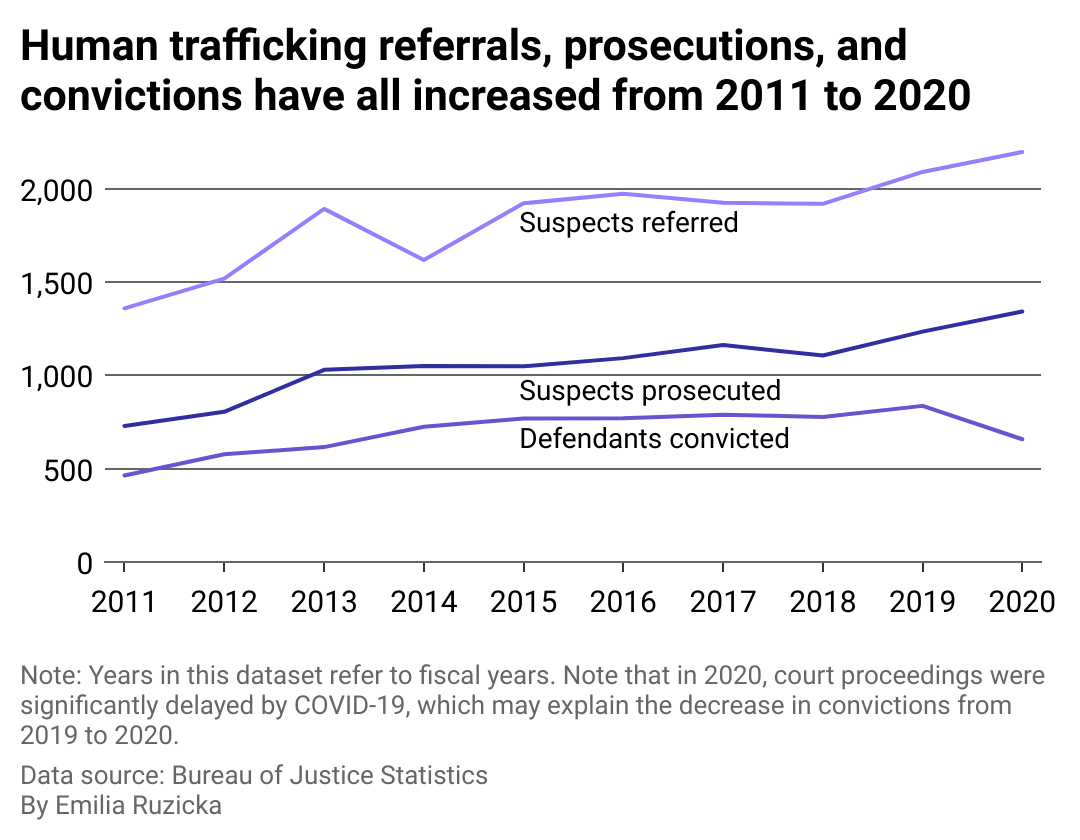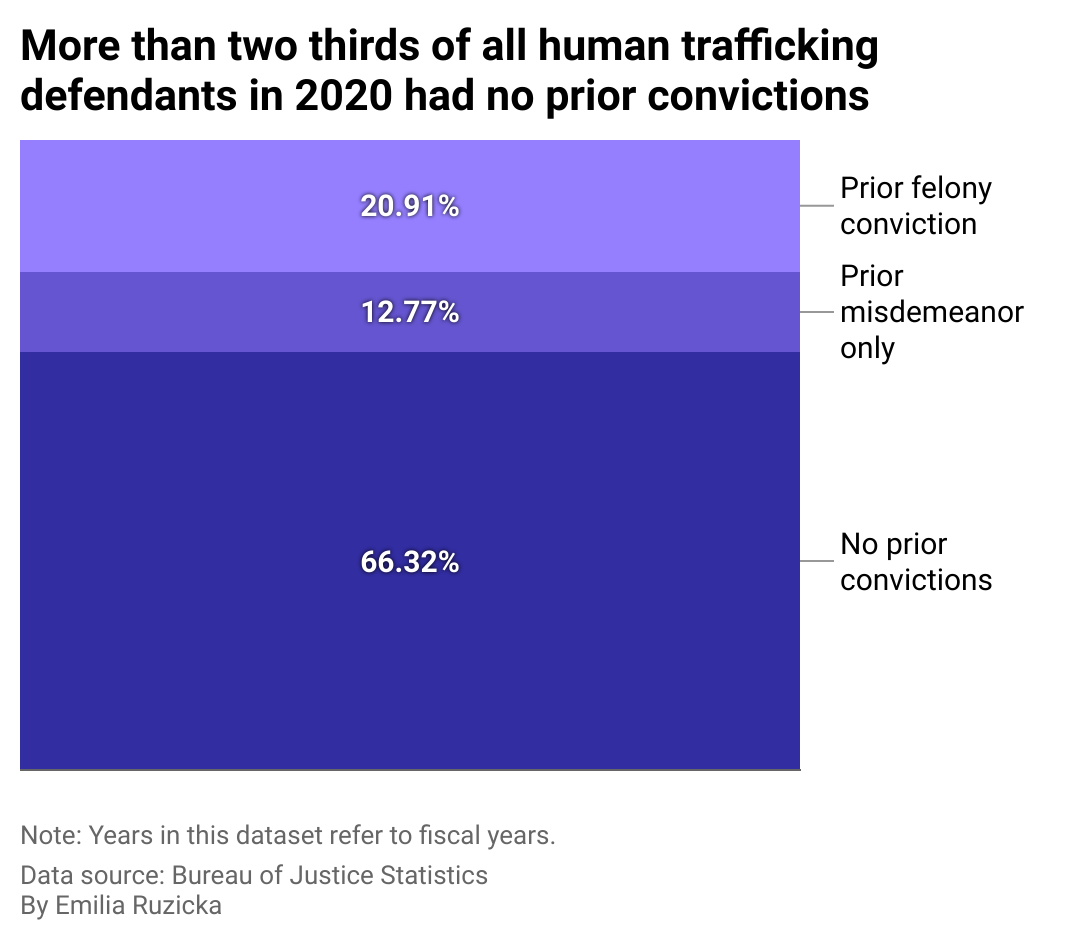What's behind the 62% jump in human trafficking offenses?

Grindstone Media Group // Shutterstock
What’s behind the 62% jump in human trafficking offenses?
Young adult holding Stop Human Trafficking sign at awareness demonstration.
The Department of Homeland Security defines human trafficking as “the use of force, fraud, or coercion to obtain some type of labor or commercial sex act.” Though many Americans may not see incidents of human trafficking close to home, these crimes can happen in any community, and their incidence has increased throughout the last decade.
Victims of human trafficking may be forced to work in illegal industries or work under unsafe or harmful conditions. Sometimes victims may work unseen behind closed doors while others may work with the public without anyone realizing they are under coercion. Conditions can include forced child labor, unlawful domestic servitude, or manipulating someone to work to pay off a debt. The UN’s 2022 Global Report on Trafficking in Persons reported that 60% of all human trafficking victims are women and girls.
Global conflicts and crises serve as major drivers behind the increasing rate of human trafficking incidents worldwide during recent decades. Roughly one-quarter of the world’s population—2 billion people—live in conflict areas, according to the United Nations.
Ninety percent of global conflicts between 1989-2016 involved some form of human trafficking, according to a Contemporary Slavery in Armed Conflict study released in 2022. And while many forms of human trafficking occur during wars and other large-scale conflicts, the most common type is the enslavement of child soldiers, which happens in 87% of armed conflicts globally.
As efforts both at home and abroad work to combat this urgent issue, Bureau of Justice Statistics shows a stark increase in human trafficking offense referrals over the last decade in the US. Northwell Health partnered with Stacker to analyze these trends using BJS data to explore why reports of human trafficking are climbing so dramatically.
![]()

Northwell Health
Referrals, prosecutions, and convictions
A line chart showing that human trafficking referrals, prosecutions, and convictions have all increased from 2011 to 2020.
The 2000 Trafficking Victims Protection Act was the first federal law that addressed modern involuntary servitude, granting FBI the authority to investigate human trafficking matters and prosecute perpetrators to the fullest extent of federal law.
By 2012, the U.S. had its first National Slavery and Human Trafficking Prevention Month, proclaimed by President Barack Obama on Dec. 30, 2011. This declaration, accompanied by an awareness campaign, may help explain the sharp spike in human trafficking referrals in the U.S. from 2012 to 2013 as more people were made aware of the illegal activity and reported it.
Human trafficking incidents that occurred during the long tail of the COVID-19 pandemic may be underreported worldwide due to decreased social interaction pushing crime “further underground,” according to the United Nations Office on Drugs and Crime.
Though the U.S. did not see a dip in human trafficking referrals in 2020, the increased barriers to leaving dangerous living situations may have incited more human trafficking offenses than are depicted in the BJS report or increased the rate at which people chose not to report human trafficking.

Northwell Health
Prior conviction status of offenders
A stacked bar chart showing that more than two thirds of all human trafficking defendants in 2020 had no prior convictions.
In addition to the majority of defendants charged with human trafficking being first-time defendants in 2020, 62% were white, and 95% were U.S. citizens. This fact disproves the myth that immigrants or people of color are more likely to commit crimes that involve human trafficking.
In fact, according to Polaris, the organization that operates the U.S. National Human Trafficking Hotline, recent migration or relocation is a significant risk factor for being a victim of human trafficking, not an offender.

Northwell Health
State prison admissions
A table demonstrating that state prison admissions for human trafficking have decreased from 2016 to 2020, but they now make up a greater proportion of overall admissions than they did in 2016.
At the end of 2020, 1,564 people convicted of human trafficking were in the custody of state prisons in 47 states reporting data to the BJS. The precise definition of human trafficking crimes varies by state; therefore, the potential jail sentences accompanying these crimes when a defendant is found guilty also cover a wide range.
At the federal level, the prosecution of human trafficking initially fell under the enforcement of the 13th Amendment, which outlaws slavery and involuntary servitude. When Congress passed the Trafficking Victims Protection Act in 2000, they established tools and resources to protect victims, prevent incidents, and prosecute human trafficking offenses.
The TVPA has been reauthorized and expanded eight times since its initial passing, most recently in 2018, as the Frederick Douglass Trafficking Victims Prevention and Protection Reauthorization Act.
Continued vigilance and awareness are key to combating this global issue that can happen in any community. In addition to January being designated National Slavery and Human Trafficking Prevention Month, the National Human Trafficking Hotline (1-888-373-7888) is a toll-free, multilingual helpline that takes tips 24 hours a day and offers information on anti-trafficking resources.
Globally, the UN Human Rights Office has been working to address trafficking with projects including establishing a compendium on contemporary forms of enslavement and human trafficking, providing airplane cabin crew with information on how to identify trafficking victims, and partnering with international groups to craft policies that prevent modern slavery and child labor.
Story editing by Brian Budzynski. Copy editing by Kristen Wegrzyn.
This story originally appeared on Northwell Health and was produced and
distributed in partnership with Stacker Studio.





